
Occasionally when we have motorhome or campervan guests at Horton Common who stay for just one night, its because they are travelling to have work done on their vehicle. A couple of times over the years, I’ve had guests stop over on their way to have air suspension systems fitted. I’ve had discussions with these guests on why they have opted for an air suspension setup. For instance, why do they feel its worth the cost? When it comes to the cost of air suspension for motorhomes/campervans, there is a big difference between them.
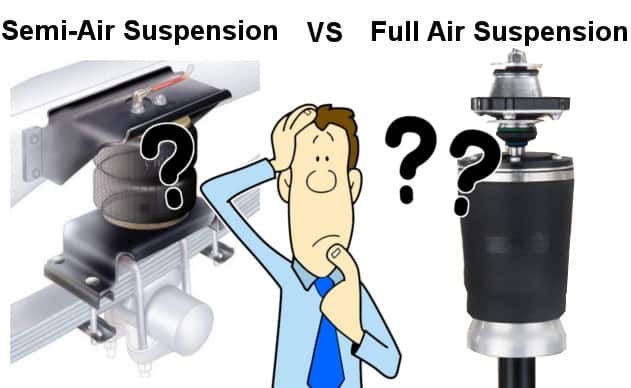
At the budget end, there are semi-air suspension systems, also known as supplementary air suspension. At the premium end, there are full air suspension systems.
In this post, I discuss the differences between the two systems. Furthermore, which may be the better option for you and your motorhome or campervan.
One of the first questions you may be asking yourself is. Why would a campervan or motorhome benefit from air suspension?‘.
Well, there are a couple of reasons. Its important to note, however, the benefits vary between semi and full-air suspension systems.
There is something important to remember about many motorhomes, they start life as commercial vehicles. Take panel van conversions. These motorhomes are simply fitted-out commercial vans.
We even have some guests who have done their own DIY panel van conversions after purchasing a used commercial vehicle.
Sometimes commercial vehicles drive around empty, and sometimes they’re full. Hence the weight of the vehicle varies.
The suspension has been designed to cope with that scenario the best it can. However, a motorhome is pretty much a fully-loaded commercial vehicle all the time.
Hence, the original commercial vehicle suspension operates at close to its maxium design all the time.
Therefore, this is where air suspension systems can either assist the original suspension or replace it completely.
Disclaimer: Hey! By the way… any links on this page that lead to products on Amazon or Caravan Guard are affiliate links, and I earn a commission if you make a purchase, with no additional cost to you 🙂
- Dissolves waste and removes odours naturally and has delightful mild fragrance
Want To Visit Horton Common? – Book Here
Table of Contents
Introduction To Air Suspension Systems For Motorhomes & Campervans
Before we can discuss the pros and cons of semi-air suspension setups and full-air suspension setups for motorhomes and campervans, we need to discuss what they are and how they work.
To save me writing an additional couple of thousand words, I’d encourage you to watch the video below from Practical Motorhome.
The differences between semi and full-air suspension setups are discussed, along with the cost implications.
Furthermore, while you may want to venture on a DIY semi-air suspension project, its very important you leave a full air suspension setup to the professionals.
Air suspension setups can make a considerable improvement to ride comfort and handling in a motorhome. Especially to vehicles that are laden very close to their chassis maxium weight capacities.
This is a good time to reference my post on motorhome weight plates. Below I’m now going to discuss in more detail the options of a semi and full air suspension setup for your motorhome or campervan.
Semi/Supplementary Air Suspension Setups (DIY Or Professional)
The first option you could consider for your motorhome/campervan is a semi, also known as a supplementary air suspension setup.
If you are reasonably DIY-minded, provided you have the right equipment and space to safely jack up your motorhome on axle stands, this can be a DIY option.
This type of air suspension does not involve removing any original suspension components. You are simply adding additional suspension/damping.
They are also sometimes referred to as ‘inflatable air assistors’.

A typical example of a semi/manual supplementary rear air suspension kit for Fiat Ducato based motorhomes: Image – Amazon.co.uk
Improving Leaf Spring Suspension
We previously had guests at Horton Common who had purchased a second-hand used Hymer motorhome. They were stopping with us for a night on their way to have semi-rear air suspension professionally fitted.
While they were really enjoying their motorhome, they had noticed that the back of the Hymer was drooping down. Going around corners (especially roundabouts) didn’t feel very comfortable or safe.
On many motorhomes, the rear suspension is leaf springs. A very tried and tested form of suspension. Its literally the same type of suspension fitted to horse and carts.
Its a very robust suspension setup, however, over time, it does start to flatten out. Hence, those leaf springs start to become less springy.
This can lead to what is commonly referred to as a ‘droopy rear end’. However, if your leisure vehicle is based on an AL-KO motorhome chassis, they actually use a torsion beam suspension setup.
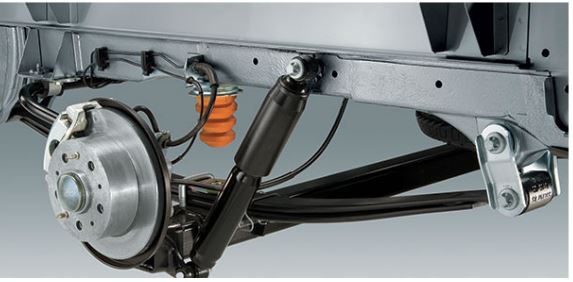
How Rear Semi-Air Suspension Can Help
As stated above, a motorhome is almost always close to fully laden. Hence close to the maxium travel of the leaf springs before they hit the axle.
Between the axle and the leaf springs is rubber bump stops. When leaf springs become tired, going over bumps will often result in the springs hitting the bump stops on the axle.
This can produce a very crashy and uncomfortable ride. Furthermore, when leaf spring suspension starts to become tired (less springy), it doesn’t properly support the vehicle when taking corners or roundabouts.
The motorhome can lean considerably, potentially even dangerously, if the motorhome enters the turn with too much speed.
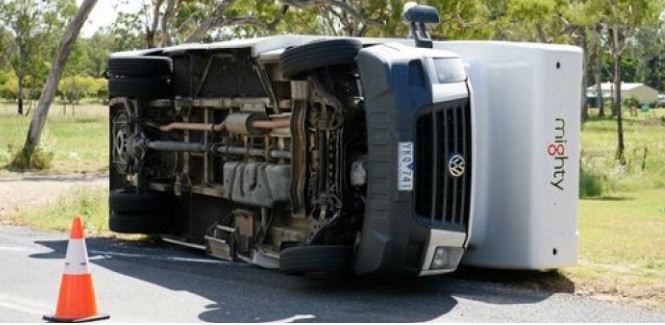
Well, those rubber bump stops between the leaf springs, and axle can be replaced with air bladders.
These air bladders can then be inflated manually with a bike or foot pump to a sufficient pressure (10-75 PSI) to provide additional support and damping.
Therefore the air bladders help to reduce a ‘droopy rear end’, providing additional damping for a more comfortable ride, and they help to reduce lean when cornering.
Rear air suspension dampers can help, especially with motorhomes with long overhangs and large rear garage lockers.
With this type of layout, while your outfit may be under its road-legal weight, it can produce problems with weight distribution.
Uneven weight distribution can be another contributing fact to poor on-road handling, which inflatable rear air bladders can help to mitigate.
However, its still important you know how to weigh a motorhome to check you are actually legal to be on the road. Furthermore, you need to know how to safely load your motorhome.
How To Fit A Semi-Air Suspension Setup
With a semi/supplementary rear air suspension kit, you are not removing any suspension components you are just adding parts.
This is potentially a DIY project if you are sufficiently capable and have the required space and tools.
Something that is important to note is rear air bladders are to help the existing rear suspension, not replace it. If one or more of the rear leaf springs are snapped, they will need to be replaced first.
In terms of fitting inflatable air assistors, Practical Motorhome has actually produced another very informative video with Diamond Dave.
As shown by Dave in the video above, the installation of rear air bladder suspension in a motorhome is relatively straightforward. Brackets are fitted between the axle and leaf springs. The air bladder sits between the brackets.
A pipe to carry the air to inflate the bladders then needs to be installed. Its obviously important to provide sufficient flex in this air pipe as the air bladders will be moving up and down along with the leaf springs.
Manual or 12V Air Compressor Bladder Inflation
You have two options for the setup with regard to how the rear air bladders can be inflated.
You can simply have individual Schrader valves for the left and right bladders or a single manual inflation point along with a pressure gauge.
Alternatively, you could opt for an onboard 12V air compressor with a control panel, gauges and pressure relief valves.
Such a setup will obviously cost several hundred pounds, but having an onboard built-in air compressor can also be handy for blowing up your motorhome tyres and other air accessories.
Full Air Suspension Setups (Professional Fitment Only)
Now I’ve discussed rear semi-air suspension installations for motorhomes and campervans, let’s discuss full installation setups. Hence, what we are now looking at is full suspension replacements.
In other words, those rear leaf springs will be removed and sent off for scrap. In their place will be new steel suspension arms with large air bladders to provide all the damping.
As noted previously in this post, full-air suspension setups are not a DIY project.
By trying to do a full air suspension setup your self, you will invalidate any vehicle warranty, and you will also invalidate your insurance.
You will need a professional installer for a full air suspension installation on your motorhome.
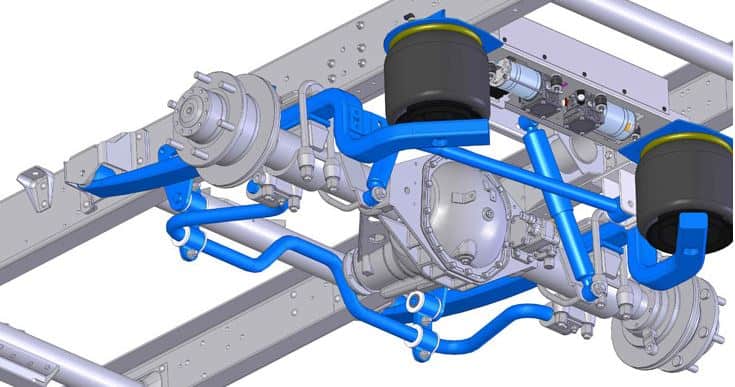
Additional Benefits Of Full Air Suspension vs Semi-Air Suspension
With a full air suspension setup on a camper or motorhome, while you will have to pay considerably more (£5-8K), there are lots of additional benefits:
- Reduced body roll and improved straight line and cornering stability.
- The ability to increase ground clearance for ramps (ferry ramps etc).
- Further improved ride comfort (handles potholes better).
- Automated on-site levelling (benefits for 3-way fridges/shower drains).
Example Of A Full Air Suspension Setup On A Motorhome
Below is a video of a full rear air suspension setting being fitted to a motorhome. In this instance, its a VB-Air Suspension kit. VB-Air Suspension is a company based in Holland.
However, they also have a UK subsidiary based in Blackburn. They offer a wide range of full-air suspension kits for a wide range of vehicles.
They appear to offer a range of solutions for pretty much any base vehicle used for motorhomes and campervans.
Now, the video above is one of the best examples of a full-air suspension replacement on the rear of a motorhome I could find.
However, instead of a full air suspension replacement, this could be probably be described as a hybrid.
While the whole of the rear leaf spring suspension was replaced, the front suspension was not upgraded with air suspension. The likely reason is cost.
Most of the issues with suspension on motorhomes are due to the rear suspension setup. Therefore, for the additional cost of air suspension on the front, you might not think its actually worth it.
Yes, with air suspension at the front, you will get better ride quality and the ability to lower the cab’s entrance step.
However, adding front air suspension will add thousands more to the cost of the air suspension installation.
It is likely, though, that the 12V onboard air compressor shown in the video above is capable of providing sufficient air for a future front air suspension upgrade if the owners wanted to take that step in the future.
You will also notice the 12V air compressor does not inflate the suspension bladders directly. A small air tank provides the boost to fill the bladders with air.
Full Air Suspension Auto-Level
In my post on how to level a motorhome, I discuss how to do it with levelling ramps. However, if you are already interested in a full air suspension setup having the ability to auto-level is a nice feature to have.
Though it must be noted air suspension manufacturers such as VB-Air Suspension state that VB-AutoLevel is an optional extra.
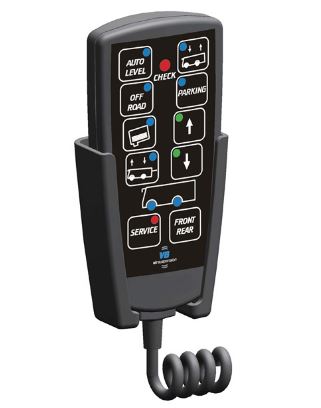
If you have a 3-way fridge in your motorhome or campervan, its vital that your leisure vehicle is level for it to work properly.
If you’re not sure if you have a 3-way fridge, just look for the fridge vents on the outside of your motorhome or campervan.
The Limitations Of Air Suspension Auto Levelling
Something that is important to note is an air suspension levelling system, while very handy, can only cope with ground which is gently sloping/uneven.
After all, the maxium amount of travel up or down with the air suspension is limited by the size of the bladders.
On any extremely uneven ground, you may still need to use levelling ramps along with the automated air suspension levelling feature.
If you want automated levelling with more range of motion, then a hydraulic self-levelling system would be required.
I’ve previously written about caravan hydraulic self-levelling systems, but I still need to write a post on such setups for motorhomes.
Conclusion On Motorhome Air Suspension Setups
Quite a few of our guests over the years have told me about the semi-air suspension setups that they have fitted to assist the rear suspension on their motorhomes, and they were very happy with the results.
I’ve only had one guest that I recall who has discussed with me their full air suspension setup.
Limited mobile was the reason they went with a full air suspension setup, along with a hydraulic self-levelling setup.
In reality, most campervan and motorhome owners will struggle to justify the investment of up to £8,000 for a full air suspension setup.
However, I think for less than £500, semi/supplementary air suspension on the rear axle is worth considering in almost all cases.
Thanks for reading, I hope you found this post useful and informative.
I also hope in the near future, you will consider coming to visit us here at Horton Common Campsite to enjoy our amazing views over the Staffordshire Moorlands and Peak District National Park. 🙂
FAQ
Besides VB-Air Suspension the likes of AL-KO and Goldschmitt also offer full air suspension kits for motorhomes and campervans.
Want To Visit Horton Common? – Book Here


